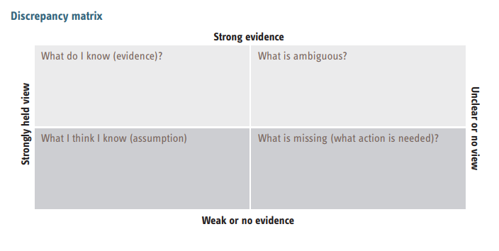The definition of an adult at risk requires an assessment to be made about the risk of harm to the person at the outset. Risk is the possibility of beneficial and harmful outcomes and the likelihood of their occurrence in a stated timescale.
Risk assessment means making analysis about:
- The individual’s capabilities and coping mechanisms (social, material and personal).
- The gains for the individual’s physical, psychological and emotional wellbeing.
- Possible disadvantages and harms.
- The values placed on the outcomes.
- The consequences for the individual of not going ahead with the activity.
- The presence and impact of coercive control, disguised compliance or undue pressure.
Undue Pressure
An adult at risk can be considered to be under undue pressure if they are refusing consent and:
- The person causing the harm, that the order or action is intended to prevent, is someone in whom the adult at risk has confidence and trust.
- Pressure applied by the person that the adult is afraid of, or threatening them and the adult does not trust them.
- Pressure applied by person not causing harm (e.g. a relative not suspected of causing harm) but does not want the council to intervene.
Protection Orders
What follows are the salient points of each of the Protection Orders. This does not replace the more detailed information contained within the Act and the Code of Practice (2022). These should be referred to if consideration is being given to an application under this part of the Act.
Any protection order under the Act represents a serious intervention in an adult's life, a sheriff must be satisfied that the council has reasonable cause to suspect the person in respect of whom the order is sought is an adult at risk who is being, or is likely to be, at risk of serious harm. Where the adult has the capacity to make decisions, the application cannot be granted by the Sheriff if the adult does not consent to the order unless it can be proved that the adult has been subject to undue pressure to refuse consent. This does not require to be proven where the adult lacks capacity. Each order may only be executed once.
Assessment Orders – Warrant for Entry
The purpose of an assessment order is to determine whether the adult is an adult suspected to be at risk; and whether there is reasonable cause to suspect that the adult at risk is being, or is likely to be, seriously harmed; and whether any action should be taken to protect the adult from serious harm.
Application for an assessment order must be made by the council's legal department, which authorises the council, if necessary, to take the adult from a place being visited under the order to allow:
- the interview to be conducted in private and /or
- a private medical examination by a health professional nominated by the Council.
When an assessment order is granted, the sheriff must also grant a warrant for entry under Section 37. The warrant for entry to accompany an assessment order will detail a specified place and only that place can be entered using the warrant. The warrant permits a constable to accompany a Council Officer and to do anything, including the use of reasonable force, where necessary which the constable considers to be required in order to fulfil the object of the visit. Only the constable has a right to use reasonable force.
The date specified in the order may be different from the date the order is granted. The assessment order is valid for 7 days after the date specified in the order. For example, an order dated 13 November would expire at midnight on 20 November. An assessment order does not
contain powers of detention. The adult can refuse to be interviewed or examined despite the assessment order.
Removal Orders
A removal order is primarily for protection and not for a council interview or a medical examination. It permits the person named in the order to be moved from any place to protect them from harm. For example, the place the adult at risk actually lives may however be a contributory factor in the harm and the move may provide "breathing space" for the specified person.
The council can make application to the Sheriff (or Justice of the Peace in certain circumstances) for a Removal Order, which would allow the removal of the adult to another place primarily for the purposes of protection.
There is a 72 hour period in which to enact the removal order. It expires 7 days (or such shorter period as may be specified in the order) after the day on which the person specified in the order is moved to the named place of safety.
A removal order does not contain powers of detention. The adult can refuse to be interviewed or examined despite the removal order.
Banning Orders or Temporary Banning Orders
These orders will only be granted where the adult at risk is in danger of being seriously harmed,
A banning or temporary banning order, which bans the subject of the order from a specified place, may have other conditions attached to it, and may last for a period of time not exceeding 6 months. The purpose of these orders is to better safeguard the adult at risk's well-being and property more effectively than would removing the adult from a place where they are at risk of harm from another person.
A banning or temporary banning order may:
- ban the subject from being in a specified area in the vicinity of the specified place;
- authorise the summary ejection of the subject from the specified place and the specified area;
- prohibit the subject from moving any specified thing from the specified place;
- direct any specified person to take specified measures to preserve any moveable property owned or controlled by the subject which remains in the specified place while the order has effect;
- be made subject to any specified conditions; and
- require or authorise any person to do, or to refrain from doing, anything else which the sheriff thinks necessary for the proper enforcement of the order.
A condition specified in an order may authorise the subject of the order to be in a place or area from which they are banned, but only in specified circumstances, for example while being supervised by another person or during specified times.
An application for a banning order may be made by or on behalf of:
- an adult whose well-being or property would be safeguarded by the order; or
- any other person who is entitled to occupy the place concerned; or
- a Council.
Power of Arrest
The sheriff can make a decision to attach a power of arrest based on the facts and circumstances of the case presented. This would be based on the likelihood of the subject breaching the banning order or any of the conditions attached to the banning order.

